Birdfinding.info ⇒ A widespread Australian species that is nonetheless easily missed as it is generally absent from most of the continent’s heavily settled areas. The main exception is Brisbane, where it can be found consistently just west of the outer suburbs: e.g., around Atkinson Lagoon and Lake Clarendon. Otherwise mostly a bird of the Outback, where it is among most common and familiar species. Regions where it is readily found include western Queensland, Alice Springs, the Kimberleys, and the northwestern portion of Western Australia.
Cockatiel
Nymphicus hollandicus
Australia: mostly tropical arid and semiarid zones of the interior.
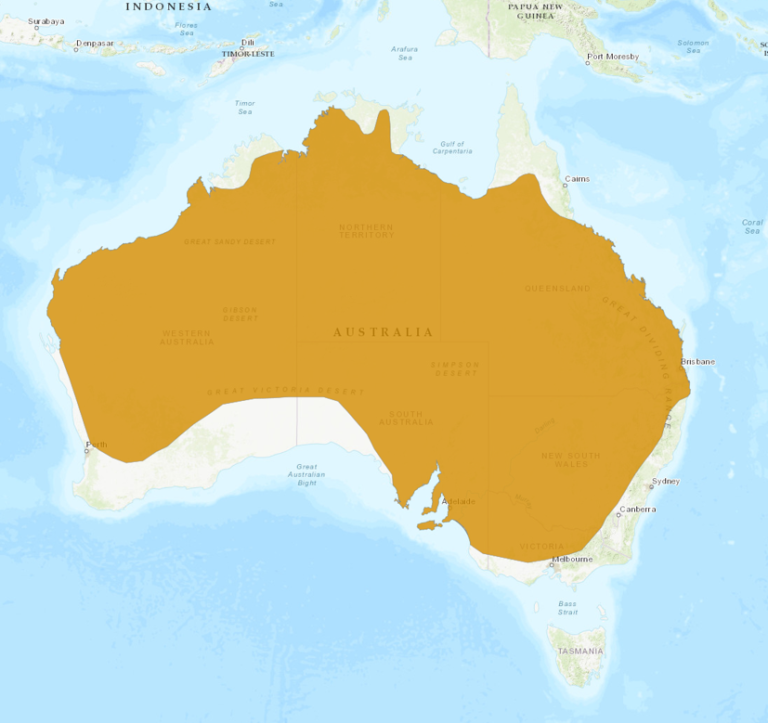
Absent from the mountains and coastal lowlands of New South Wales and Victoria, and from northeastern Queensland. Sparse or sporadic across most of the southwest and western Outback, and coastal areas of the Northern Territory.
The Cockatiel is among the most popular of cagebird pets, a mainstay of global aviculture, and therefore familiar worldwide. Although escaped or released individuals are often encountered flying free in Europe, Asia, and the Americas, and around Australian cities, no feral populations have been reported.

Cockatiel flock visiting a ranch pond to drink. (Latoka Farm, Bourke, New South Wales, Australia; June 18, 2017.) © David Ongley
Identification
Unique and unmistakable: a small, thin, long-tailed, gray parakeet with a clownish facial pattern and tall frontal crest.
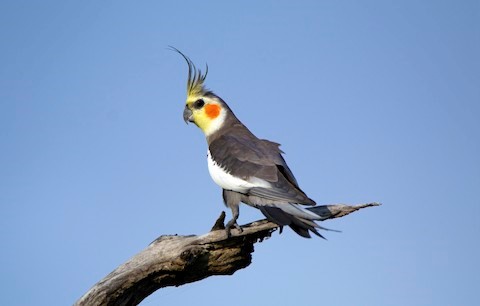
Cockatiel, male showing maximally bold contrast in its facial pattern. (Lake Clarendon, Queensland, Australia; January 25, 2017.) © Nik Mulconray
Although its shape is that of a parakeet, the Cockatiel is in fact an aberrant cockatoo. The most prominent indicative feature is its pointed crest, which is comprised of long, wispy feathers that are a variable mix of yellow and gray.
The plumage is mostly medium or dark gray overall except for a prominent white wedge on the upperside of the wing, a predominantly white-and-yellow head, and a circular orange patch on the cheek.
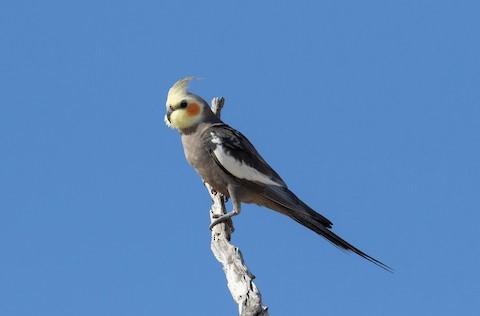
Cockatiel, male with fluffy facial plumage puffed up. (Lake Pinnaroo, Sturt National Park, New South Wales, Australia; October 2, 2020.) © Richard Webber

Cockatiel, male at nest, dorsal view. (Lake Wyangun, New South Wales, Australia; November 25, 2017.) © Joe Smith
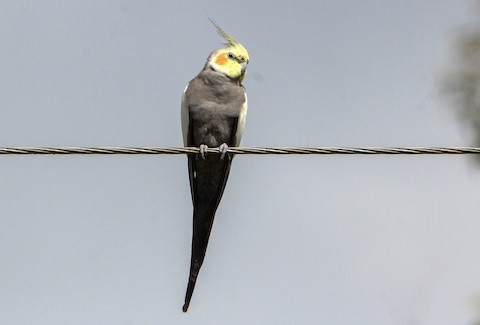
Cockatiel, male, ventral view showing long pointed crest and tail. (Ramsay, Queensland, Australia; May 4, 2018.) © Sandra Gallienne

Cockatiel, male in flight with tail fully spread. (Latoka Farm, Bourke, New South Wales, Australia; August 17, 2020.) © David Irving
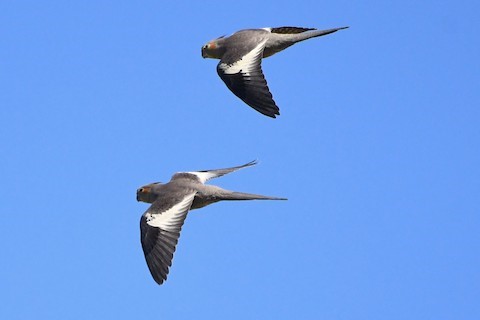
Cockatiels in flight, dorsal view showing white wedges on the secondaries and secondary coverts. (Pecheys Lagoon, Lower Tenthill, Queensland, Australia; May 24, 2020.) © Wayne Schulz
Both sexes have approximately the same coloration and pattern, but the female’s head coloration is more muted: mostly gray instead of boldly contrasting white and yellow.
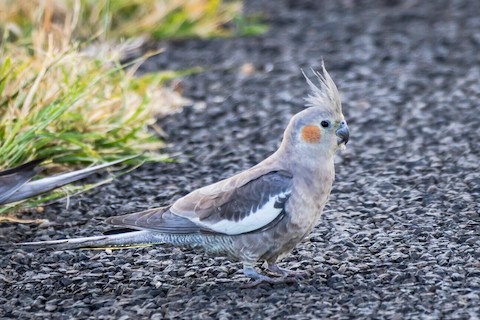
Cockatiel, female. (Irvingdale, Queensland, Australia; June 10, 2018.) © Bob Durant
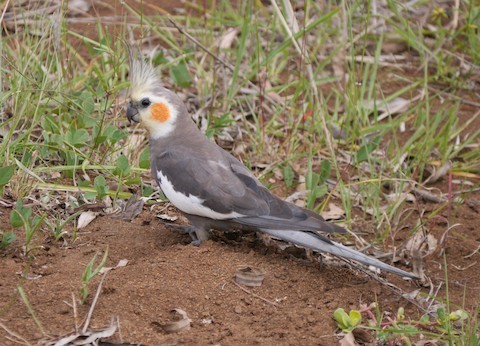
Cockatiel, male. (Allora, Queensland, Australia; December 20, 2015.) © Frank Coman

Cockatiels, two females at left, two males at right. (Latoka Farm, Bourke, New South Wales, Australia; August 17, 2020.) © David Irving
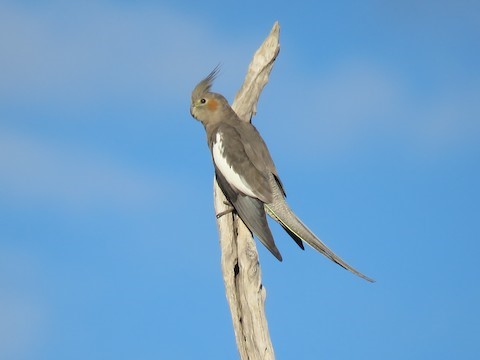
Cockatiel, female. (Bladensburg National Park, Queensland, Australia; May 28, 2016.) © Richard Arnold
The sexes also differ noticeably in the undersides of the wings and tail. Males have uniform gray underwings and blackish undertails. Females have white spots on the underwings and fine gray-and-yellow barring on the undertail coverts and undersides of the tail feathers.
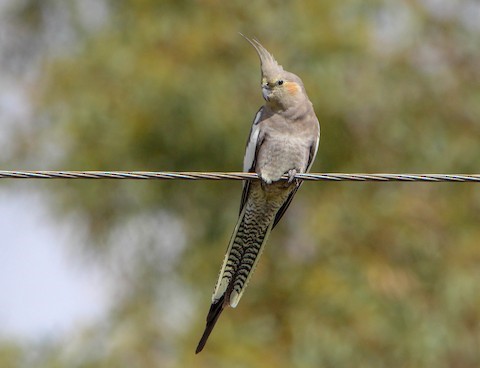
Cockatiel, female showing black-and-yellow barring on the undertail. (Ramsay, Queensland, Australia; May 4, 2018.) © Sandra Gallienne
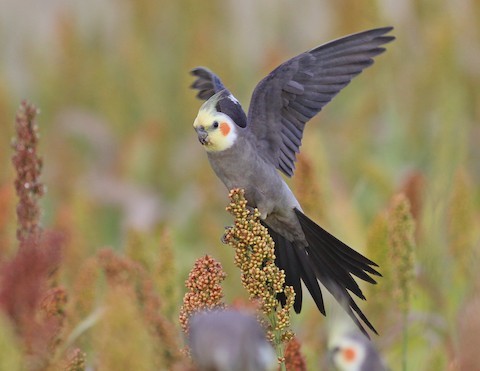
Cockatiel, male showing uniform gray underwings and black undertail. (Elsmore, New South Wales, Australia; April 11, 2020.) © Rufus Wareham
Immatures generally resemble females, so subadult males may show intermediate coloration and patterns on the head, underwings, and undertail.

Cockatiel, male in flight, ventral view showing uniform gray underwings and blackish undertail. (Lake Cargelligo, New South Wales, Australia; April 15, 2019.) © Hickson Fergusson

Cockatiel, female in flight showing spotted underwings and barred undertail. (Timber Creek, Northern Territory, Australia; May 27, 2021.) © David Irving
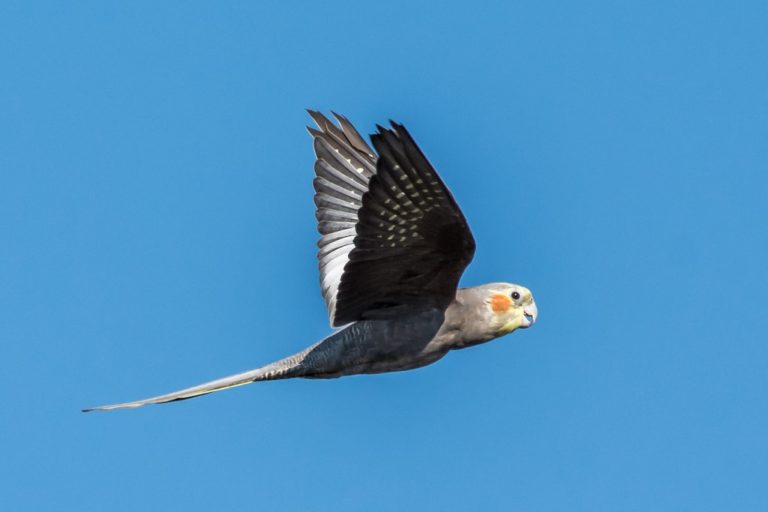
Cockatiel, an isolated escaped individual, apparently a subadult male showing plumage characters intermediate between typical male and female. (Paphos, Cyprus; December 9, 2019.) © Ray Atkinson
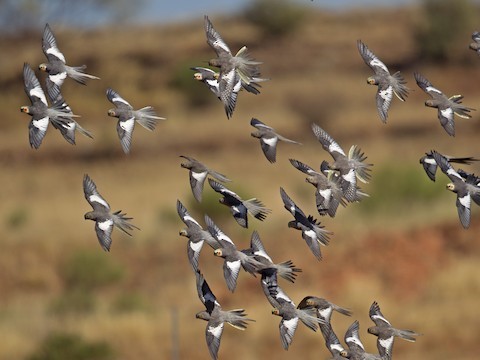
Cockatiel flock in flight, recognizable at long range by the white wedges on their wings. (Santa Teresa Road, Northern Territory, Australia; April 2, 2017.) © Mat Gilfedder
Notes
Monotypic species.
References
BirdLife International. 2018. Nymphicus hollandicus. The IUCN Red List of Threatened Species 2018: e.T22684828A132056250. https://dx.doi.org/10.2305/IUCN.UK.2018-2.RLTS.T22684828A132056250.en. (Accessed September 25, 2021.)
eBird. 2021. eBird: An online database of bird distribution and abundance. Cornell Lab of Ornithology, Ithaca, N.Y. http://www.ebird.org. (Accessed September 25, 2021.)
Forshaw, J.M. 2010. Parrots of the World. Princeton University Press.
Juniper, T., and M. Parr. 1998. Parrots: A Guide to Parrots of the World. Yale University Press.
Xeno-Canto. 2021. Cockatiel – Nymphicus hollandicus. https://www.xeno-canto.org/species/Nymphicus-hollandicus. (Accessed September 25, 2021.)
